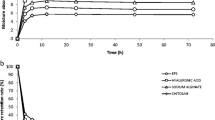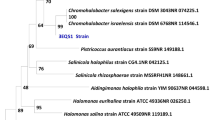The effects of monovalent and divalent cations on the rheological behavior of Halomonas eurihalina exopolysaccharide (EPS) were studied. Sodium, potassium, magnesium and calcium were added and the relative abilities to increase viscosity were as follows: KCl > NaCl > MgCl2 > CaCl2. The highest viscosity value was measured in acidic 10−4 M KCl, in which a gel formed. A loss of sulfate content seemed to correlate with the increase of viscosity. H. eurihalina produced EPS in all growth media. Addition of hydrophobic substrates to culture media produced changes in chemical composition and emulsifying activity of the EPS. Xylene was the most effectively emulsified substance and the EPS produced on tetradecane and on corn oil the most active emulsifier.
Similar content being viewed by others
Author information
Authors and Affiliations
Additional information
Received 25 July 1997/ Accepted in revised form 30 January 1998
Rights and permissions
About this article
Cite this article
Calvo, C., Martinez-Checa, F., Mota, A. et al. Effect of cations, pH and sulfate content on the viscosity and emulsifying activity of the Halomonas eurihalina exopolysaccharide. J Ind Microbiol Biotech 20, 205–209 (1998). https://doi.org/10.1038/sj.jim.2900513
Issue Date:
DOI: https://doi.org/10.1038/sj.jim.2900513




